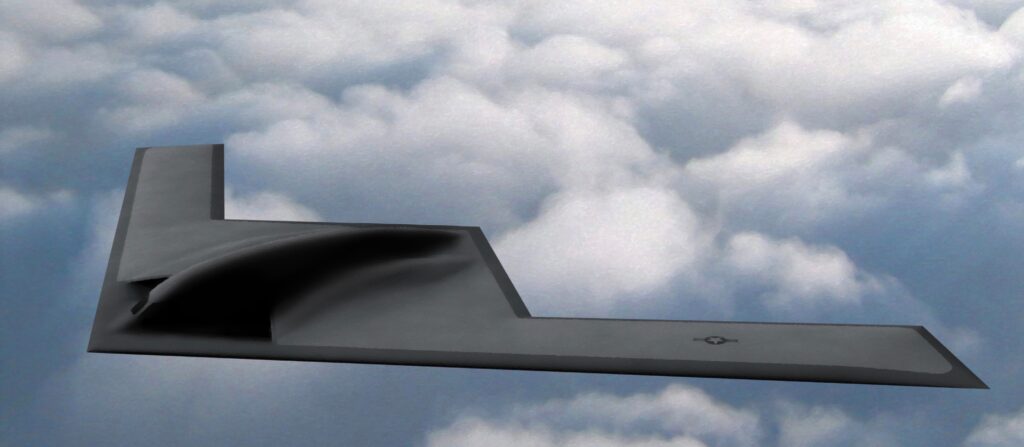
B-21 artist rendering
CORRECTED: What Gen. Harris Meant To Say Was A Total Bomber Fleet of 165; Still “At Least” 100 B-21s
WASHINGTON: How many B-21 bombers will the US need? 80? 100? 165? Bound by the president’s budget on one side and congressional appropriations on the other, the head of Air Force acquisition was very careful in answering that question today, but one of his colleagues gave some fascinating hints.

Lt. Gen. Arnold Bunch
The military head of Air Force acquisition, bound by the twin bonds of budgets and Congressional appropriations, was very careful in answering that question today.
The number is “at least 100,” based on careful analysis of highly classified war plans, training needs and the likely pace of depot repairs, Lt. Gen. Arnold Bunch told the House Armed Services seapower and force projection subcommittee at an early morning hearing.
That figure of 100 has been holy writ for the Air Force for some time. Originally, the public was told the U.S. needed 80 to 100 B-21 Raiders. Then we were told the number was at least 100. Today, Lt. Gen. Jerry Harris, deputy chief of staff for strategic plans, programs and requirements, told Wisconsin Republican Mike Gallagher that 165 “is probably what need to have,” based on the full spectrum of war plans.
Gallagher carefully led the three-general panel, asking them about a Mitchell Institute study, “US Bomber Force: Sized to Sustain an Asymmetric Advantage for America.” The study estimates that war with Russia would require 258 bombers, Iran would need 103, and North Korea 60. That’s based on the number of targets and bombs needed, the sortie rates the bomber force could sustain and the number of days the campaign would last.
Harris told Gallagher the estimates in the Mitchell study “aren’t incorrect,” adding that “165 (bombers) is probably what we need to have,” he said, adding that he and the Air Force didn’t want “to get ahead” of the Trump administration’s new National Military Strategy. (Remember that Chairman of the Joint Chiefs Gen. Joe Dunford said under Obama that the next strategy would be classified. Given this administration it’s unlikely they would reverse this.)
CORRECTION: Air Force public affairs contacted us to clarify that Harris meant to say the total bomber fleet would be 165 — not that the Air Force would need 165 B-21s, although that’s what he said. It’s clear the Air Force believes it probably needs more than 100 but isn’t willing to say anything about boosting numbers just yet. CORRECTION ENDS
So my guess would be that we may see a higher bomber requirement, though that won’t translate into a requirement or additional money for some time. The 2018 budget proposal includes $2 billion for the B-21.
Meanwhile, the “low-risk” tanker solution known as the KC-46 keeps encountering unexpected risks. Once again, the Air Force tells us that Boeing’s tanker is late. Bunch, responding to questions by Rep. John Garamendi, said the Air Force and Boeing are doing a risk assessment next week. Apparently, they are not plowing their test points as quickly as expected and Bunch said that, while Boeing believes they will hit the testing goals, “our assessment shows we are behind that date.”
The problem this time may lie with the Federal Aviation Administration, the people who have spent more than a decade trying to bring us a Next Generation Air Transportation System, if the faces of Bunch’s colleagues were any clue. Why do I say that? Garamendi asked Bunch if the FAA was the problem and got this wonder of an answer: “I am not in the position to say the FAA is a problem.” Garamendi noted the looks on “the faces of your colleagues,” as an indicator that the FAA was the problem.

EC-130 Compass Call electronic warfare aircraft, used for an experimental cyber attack
Finally, Bunch confirmed what my colleague Marcus Weisgerber reported last night, that Boeing had filed a protest against the Air Force award of the EC-130H Compass Call contract to L3, the longtime integrator of the high-demand, low-density asset. L3 does the lion’s share of the work on the highly classified electronic warfare aircraft and the Air Force decided that sticking with them to upgrade the plane was the fastest, cheapest and smartest approach.
Last year, of course, the Air Force tried to retire the Compass Call fleet and suggested using a new aircraft, a Gulfstream G550 business jet, to carry the EW gear made by BAE Systems. Congress did not like that idea. So the Air Force pivoted and picked L3 as the system integrator.
“L3 has played that role as the systems integrator as we have modernized these aircraft for the last 15 years. They are the ones that are very familiar with the mission equipment that is on there,” Bunch told the subcommittee. “That mission equipment is highly classified to be able to execute the electronic warfare mission that we ask that platform to do. They have all the tooling, they have all the existing knowledge, and they have the modeling and all the information to do that work.”
For those who love diving in the weeds, there was a five minute exchange about whether L3 was the lead system integrator or just the system integrator. Bunch said he had earlier misspoken when he called L3 the lead integrator. For those with long memories, the Future Combat System and the Coast Guard’s Deepwater were both built using LSIs, where the government delegated all sorts of decisions to a contractor that historically hadhd been made by federal officials. Both programs came in for blistering criticism, FCS was canceled, and the Deepwater program was substantially restructured. That’s among the reasons Bunch didn’t want to call L3 an LSI.
Northrop sees F-16 IVEWS, IBCS as ‘multibillion dollar’ international sales drivers
In addition, CEO Kathy Warden says the company sees a chance to sell up to five Triton UAVs to the NATO alliance.


























